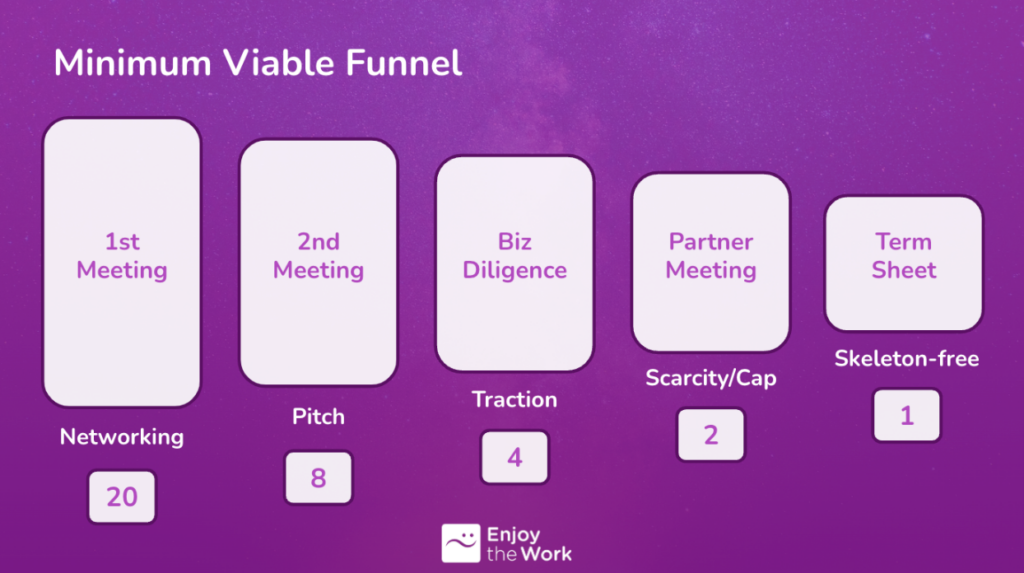Raising early-stage capital is easy, right?
It must be.
It seems virtually every other tech-related article to grace my screen tells the tale of young founders armed with little more than a set of slides raising funds from one or more esteemed investors.
Is it really that simple? Translate your fledgling business to a series of Google slides, and millions of dollars are suddenly wired in your direction?
While the stories I read suggest yes, the data suggests otherwise.
I’m writing this in January 2024. In 2023, startup funding was at its lowest level since 2018, with seed funding down 30% YoY, early-stage down 40%, and late-stage down 37%. Time between rounds was also at a ten-year high. If companies managed to raise in 2023, it took longer, they raised less, and the valuation was lower.
So what does it take to raise early-stage capital? A lot more than a pitch deck.
You’ve probably read similar blog posts written by one of a thousand venture capitalists. But here’s the thing: Enjoy the Work is not a venture firm.
Venture firms write blog posts that explain how THEIR FIRM wants to be pitched. At Enjoy The Work, we’ve guided hundreds of fundraises. What we’ve done is study how ALL FIRMS want to be pitched (whether they know it or not). And that’s the purpose of this particular post.
I’ve already done a similar deconstruction of late-stage capital raising. And now, we’re headed backward in the journey to demystify the mysterious early-stage round.
A couple of disclaimers:
- For the sake of simplicity, we’ve focused this behemoth post on B2B startups, though many of the principles would still apply to other categories.
- Much of the guidance best speaks to how U.S. investors from San Francisco, New York, Los Angeles, Seattle, and Boston behave. There are differences in how investors show up with startups across Canada, secondary U.S. markets, and Europe. And more substantial differences across Asia and LATAM.
We’ll cover:
- Why you’re failing to raise. (There are 3 reasons)
- The hidden motivation of many VCs. (It’s probably not what you think.)
- Enjoy the Work’s fundraising funnel. (Hint: it’s like your marketing funnel.)
- The 3 pillars to a successful raise. (How to build an investor list, prepare for meetings, and deliver your pitch.)
- The 28 questions all investors ask. (And the answers they seek for each.)
And if you happen to still be with me after reading all of that…
Then we’ll review the most common questions the founders we train tend to ask and the most common gaffes rookie founders tend to make.
Enjoy

Why you’re failing to raise
If you can’t raise, it’s likely due to 1 of 3 reasons:
1. You’re targeting the wrong investor.
Find the right partner; enjoy years of bliss. Choose poorly, and failure, dysfunction, and/or misery are sure to follow.
So how do you find the right match? Start with preferred check size, thesis, and dry powder.
Here’s what those terms mean.
Check size: Some funds write $50M checks. Some write checks for $500K. The capital you need and the check the investor wishes to write need to align.
Thesis: Investors have their preferences. Some target hardware, some target biotech, and others only have eyes for climate. While there are funds of such size that they will support an array of domains and stages, many funds focus on a reasonably narrow band.
Dry powder: Does the fund have money to deploy (dry powder), and is it actively investing? Anything short of an emphatic “yes” should give you pause. (I’m married now, but when I was dating, I preferred people who were actually available. The same is true for venture firms.)
2. You lack traction for your stage
In early-stage fundraising, investors are wooed by the possibility that, one day, your startup will be a billion-dollar company. Traction is industry speak for progress, and at each stage of investment, the expectations rise.
When raising Seed, investors are looking for first evidence that you have a real business — that means a market big enough to matter, a product that works, customers that pay, and a team that can execute.
When raising Series A, investors want to see a repeatable machine. You can attract, win, deploy, and delight your customers. It’s OK if some smoke is coming from the engine — investors expect rough edges. But they also expect that all of the main parts work.
At Series B (and beyond), firms want to see a scalable, smooth business. That means you’ve found leverage, allowing you to grow faster and faster with decreasing levels of effort. At this point, everything about the business works well and the only thing holding you back from world domination is capital.
3. You don’t know how to raise
There are founders who simply wing it — hoping charisma and fast-talking will elicit a term sheet. But the veterans know better — there are steps the best founders follow to increase not only their chances of receiving a single offer but many.
The hidden motivations of many VCs…
Before I continue, I need to make a few things about VCs crystal clear:
- They make money by making investments.
- They invest other people’s money. (These people are called limited partners or LPs.).
- Most venture investors only make only a handful of investments each year.
- They are only held accountable by their LPs for the investments they actually make.
- They are not held accountable by their LPs for the investments they do not make.
- They lose their job by making (too many) bad investments.
Passing on a deal costs the investor almost nothing. VCs say no a lot, and they say it quickly. Agreeing to a term sheet carries a great deal of risk, and the younger the VC, the greater the risk. Pick a winner, and the VC may have a job for life. Pick a loser, and that VC might be ousted from their role.
What are the implications for a founder? To remember that venture investors are more risk averse than their job title might suggest.
Enjoy the Work’s Fundraising Funnel
Great operators obsess about funnels. You have a recruiting funnel. A marketing funnel. A sales funnel. Why should capital raising be any different?
Part of the struggle young founders have is that fundraises feel impossibly binary — either you receive a term sheet or you don’t. They don’t understand the leading indicators suggesting whether a raise is on or off track.
That is the utility of a funnel…

Let’s define the steps.
First meeting. Typically 30-45 min long. The venture investor uses this meeting to answer a single simple question: “Do I wish to spend more time evaluating this company?” A high-profile venture firm might experience 2,000 such pitches in a year and only make 10-15 investments. Therefore, the founder’s goal for a first meeting? Earn a second meeting…
Second meeting. The second meeting looks a lot like the first with 3 key differences: 1), the investor often brings a colleague 2), the meeting typically is longer and 3), the questions (aka objections) tossed at the founder are more difficult.
Why a colleague? Because venture firms typically are structured as partnerships where major decisions (such as whether to invest) are left to a vote. Bringing in a colleague begins the socialization process.
Why longer? Because now the investor is not just trying to get an initial feel for an opportunity, they are beginning the diligence process. And that means coming to the meeting armed with very specific questions to resolve.
That brings us to the third key difference — every question VCs pose to founders in this dance are actually objections (aka reasons not to invest) dressed as curiosities. With each subsequent interaction you have with an investor, the questions will rise in difficulty. More on this in a bit…
Business diligence. For early-stage companies, there is not that much for an investor to study. Your financial history is limited. Your user and/or product data is young. The team is small. But whatever does exist, you can be sure it will be scrutinized.
Investors will take weeks (not days, and typically not months) to examine whatever information they can find about you, your team, your market, your product, your customers, and your numbers. In particular, they will be checking for consistency across the pitch you delivered, the answers (to the objections) you provided, and the facts you submitted.
Partner meeting. Venture capital firms are often legally structured as partnerships. And that means major decisions are left to a vote. While one or two members of the firm might have evaluated your startup, the entire group (which could range from just a couple of people to more than a dozen) will decide your fate. At some point in the dance, your sponsor(s) will suggest meeting the entire audience for a win or go home pitch.
Term sheet. This sacred document represents the conditions of the potential financing. It can detail everything from the amount of capital to the valuation to the board structure and more. The term sheet is the hardest step in the funnel; it reflects the honest commitment by the investor to invest in your business, leaving only some (relatively) minor lawyering and fact-checking between you and a closed round.
Overall timeline. A typical early-stage round requires about 4 months (16 weeks) from start to finish (YMMV). We encourage our founders to cluster their first meetings together over a 2-week window. Second meetings will also occur over a second 2-week window. The time required for business diligence is more varied, but 4-6 weeks is a reasonable range. Another 2 weeks for partner meetings; if successful, a term sheet will show up days, not weeks later.

How to use the funnel
A successful founder might run 2 or 3 early-stage capital raises in their career. Most venture investors have never sat in the founder’s seat. And investment bankers effectively never play in early stage. That leaves our firm with the somewhat unusual experience of having guided many dozens of early-stage capital raises. All of those reps have provided us with critical insight into two important questions —
- What is the conversion funnel of a healthy capital raise?
- If my funnel is not healthy, how do I diagnose the problem?
First — what is a healthy conversion funnel?:
- 90% of your warm intros should result in first meetings.
- 40% of first meetings should move to second meetings.
- 50% of second meetings should move to diligence.
- 50% of funds that move to diligence should proceed to partner meetings.
- 50% of your partner meetings should result in term sheets.
- 100% of signed term sheets should result in closed financings.
And the potential diagnoses if things go awry?:
- If intros are not leading to meetings, evaluate your introductory blurb and/or the teaser deck being used by your connector.
- If first meetings are not transitioning to second meetings, the pitch deck is the culprit.
- If second meetings are not moving to business diligence, it’s likely that objection handling is substandard.
- If business diligence is not unlocking partner meetings (and therefore term sheets), you’ve likely failed to create a sense of scarcity.
- And if by chance, your signed term sheet with an early-stage venture capital firm did not end in a capital raise, that likely means something in your legal materials was screwy (or worse, you lied about something).
Let’s assume you’re ready to get started. Let’s talk sequencing…

The 3 pillars of a successful raise
Your investors — how to build a list and earn some meetings
“Network when you don’t need to…” This is advice too many founders learn the hard way. Great early-stage investors seek relationships, not transactions. A single discussion, email exchange, or pitch is not a relationship. But if you’ve not put in the work ahead of time, all is not lost.
Now — how do you find those relationships? A couple of decades ago, finding and researching investors was brutal and manual. A founder had to be a private investigator to build a target list and source meetings.
Now we have a list of tools available for founders — from NFX Signal to Crunchbase to Pitchbook. Even just a thoughtful Google Bard or ChatGPT prompt would provide a quality starting place. But a list alone is insufficient. Ask yourself how many cold emails you ignore or tag as spam each day. But what if someone you know suggests you take a meeting with someone? I reflexively ignore the former and delight in the latter. Investors behave similarly.
So here are the steps:
- Connect to every influential person you personally know on LinkedIn; founders in your life who have successfully raised capital (or even better, have exited a prior startup) should be first on your list.
- Build a list of investors who match your industry, stage, and geo.
- Cross-reference the list of investors with your connections to identify warm connections.
- Craft a compelling, short blurb that your connectors can use to solicit interest on your behalf.
A great blurb matters — it’s a movie trailer designed to pique interest. Here is a recent example I wrote for one of our companies.
Subject: introduction for you
Incredibly impressed by the founder. She’s a growth expert from Facebook and LinkedIn who then went on to launch her own agency that grew consistently for the better part of the last decade. She built a number of internal systems to power her agency, and in the last year, she productized the tools to sell them to mid-market e-commerce companies. It’s really working with the key metrics all up and to the right.
She’s just starting a capital raise now to expand go-to-market efforts and I could see a fit between the two of you. Let me know if curious for an introduction.
A few comments on this blurb:
Investors, like all humans, seek patterns. Specifically, they know that evidence of social proof, momentum, prestige, and exclusivity all tend to reveal better investment opportunities. Look again at the blurb. She’s an expert in her field (prestige). She’s had prior success (social proof). The company might already be a runaway train (momentum). And she’s not yet started fundraising (exclusivity). Put it all together, and the investor might see an introduction as a chance at finding a rare gem.

Your pitch
Humans only remember things when 1 of 2 things are true — either, there is a great amount of repetition. Remember as a student how many times you had to study something for it to really sink in? Or, the experience has to be highly evocative. Investors are unlikely to meet with you many, many times to hear your pitch. More likely, you’ll get 1 real shot. And that means you have to be memorable.
And it has to happen quickly. If you ask investors how soon into a first pitch with a founder they typically lose interest, the answers might shock you. Most say less than 60 seconds. The aspiring founder has one brief minute to grab the investor’s attention, or the rest of the meeting will be an empty theater.
The sheer number of startup posts already written on how to craft an investor pitch deck is overwhelming. I’ll touch on the most common bones of a good deck below, but I don’t think there is a single platonic ideal. What matters most, in my opinion, is clarity of message and subsequent funnel measurement. If a founder is earning meetings and moving investors past a first meeting, I implore them to ignore pitch deck advice.
Rather than rehash what has been covered time and again related to the number and order of specific slides, let us zoom out on principles more than structure.
Focus first on the market opportunity, not the product
Simon Sinek said it best. Investors first want to be convinced that the problem a founder is solving is so big, so painful, and so potentially lucrative that it has to be solved. Only then will they turn their attention to your product. Too many technical founders get this backward.
People can’t read and listen at the same time
We believe we can multitask. It’s a lie. What feels like multitasking is really just rapid task switching. And that comes at a cost. The person multitasking will hear less, absorb less, and remember less. So for the love of God, don’t have your audience read the text on your slide. You’re effectively asking them to pivot between listening to you and reading — and they’ll do both suboptimally. Does that mean zero text? No, but understand that every line of text comes with a corresponding cost to attention. Choose wisely.
Be arrogantly likable
Likability alone isn’t compelling. Arrogance alone is a turn-off. The combination of the two is the golden ratio for fundraising. Investors are looking for the person who can build a billion-dollar business. There is a lot of unhelpful prejudice at play. But this post is designed to help you raise capital, not correct systemic bias. Investors want to meet the master of a domain. The person with the answers. But investors also want the founder who is likable enough that they can imagine working together for a long time to come. Find the balance. If the investor says something wrong, correct them. Just do it with a smile.
Be prepared
You’re asking professional investors to bet their funds and reputations on you. They will come with a predictable set of questions. Show up ready. Research your audience. Prep your pitch. Make sure your demo works.
Don’t inflate your resume
If an investor writes you a check, they are taking a substantial risk. They are betting the funds of their LPs and they are betting their reputation on your character. And that means even the slightest hint that something is off in a founder’s story, materials, or numbers is enough to cause the investor to run. If you have unpaid pilots, don’t call them customers. If you have free interns, don’t call them employees. A fundraise is the beginning of a long-term relationship between a founder and an investor. And like any healthy relationship, honesty is foundational.

The 28 questions all investors ask — and the answers they seek
All investors ask the same questions. Some of the questions are explicit — meaning they will ask you directly. Others are implicit and are expected to be answered within your materials. Let’s go through them one at a time.
1. What is the problem you’re attempting to solve?
State the problem simply. If the investor cannot easily and clearly share the problem with others in their firm, then go back to work. Using our firm, Enjoy The Work, as an example:
The dirty little secret to entrepreneurship is that most founders don’t know how to run a business. They know how to build a product, win first customers, and perhaps raise some capital. But give them hundreds of employees and dozens of customers and cracks would show quickly. Enjoy The Work teaches great founders how to become great CEOs.
2. What is your solution to that problem?
Again, keep this very simple. No jargon. Minimal complexity. If possible, talk about what you believe that nobody else believes.
3. What makes your team qualified for this opportunity?
This is a question about founder/market fit. What about your background (and/or that of your team) provides you with the unique knowledge, mastery, and insight to win this space?
4. Who are the co-founders?
Sadly, more startups die from suicide than homicide. Investors want to understand the depth of trust and harmony that exists among the founders. Met each other at a networking event 2 months ago? Trouble. Been best friends since undergrad? Now we’re talking.
5. What skills are missing from your team?
Investors ask this question both to find ways to be helpful (they want to make introductions) and also to gauge a founder’s capacity to be self-critical. Be transparent about your team’s missing skills, but don’t be apologetic — all early-stage companies have gaps.
6. What proof do you have that your solution works?
The more traction you have (customers, usage, revenue), the easier this question is to answer. Provide an unambiguous narrative and supporting data that shows that the product does what it was intended to do, is valued by the customer, and generates a profit.
7. What is the market you sell to? Who is your customer?
Be specific. Don’t provide a category or a type of company. You don’t sell to a company. You sell to a human. Describe that human — their title, their role, their pain, and their use case. The clearer your description, the more you demonstrate that you understand your market.
8. What is your customer’s use case?
Empathy is the key to good product and sales efforts. Show the investor the depth of your customer intimacy. Describe a day in the life of your customer. The pain they suffer. Why solving it would be so meaningful and how your solution can be the difference. The investor is guaranteed to call your customers, and the more similar the customers’ stories are to yours, the better.
9. What are the alternatives for your customer if they don’t buy or use your solution? (Derivative question: Why now?)
If you’re solving a real pain, people are already solving it somehow. Figure out what solutions are out there so you can explain how your product represents a massive improvement over the status quo — e.g., makes someone’s job easier, cuts costs, delivers precise data, etc. Many investors will also explore why today is the right time to invest in a business such as yours. If something is causing an inflection point in your market, share it here. New government regulation? New technology? New customer behavior?
10. How do you sustainably generate leads? What are your KPIs?
Share what you’ve learned about both so far, and share your current hypothesis. Perhaps your business relies on founder-driven sales today — your network, your business development efforts, your sales efforts, and your closing. But that won’t sustain, so investors will want to hear what happens next. Even if it’s just a theory for now, show investors that you’ve been thoughtful about how to create demand. Will your go-to-market efforts be sales-led? Marketing-led? Product-led? There is no wrong answer, other than not having an answer that you can support with either recent experiments or historical results.
11. How do you price your solution? How do you earn money?
Keep this answer simple while ensuring whatever you say aligns with your financial model. Do you charge for a seat license? Or per transaction? Or through ROI-based enterprise licensing fees? If there is complexity, that’s OK. That will be revealed when you walk the investor through your financial model. For now, just make sure the investor absorbs the broad strokes.
12. What is churn like today? (What are the primary causes, and how has it trended over time?)
Churn is one of the weaknesses you’ll be tempted to cover up. You’ll get defensive. Or cherry-pick data. Or worse, misrepresent history. That’s one of the biggest mistakes you can make. You’re an early-stage company, so your product is messy. You’re going to have churn, and your investors want an honest partner. So be honest. And then share what the churn has taught you and how you’ve improved the business as a result.
13. How do you measure customer engagement?
The question under the question is: “How do you know if your product is working?” This answer is unique to your business. Share openly how you measure whether customers are using and benefiting from your offering. Explain how you came to decide on those metrics, how they are calculated, and what experiments you’re running to boost performance.
14. What is required to deploy a new customer? Expense? Resources? Time? Change management?
Investors are looking for easy. Plug and play. Low-friction. They know that the more seamless the deployment and usage of a new product, the faster the startup can grow. If delivery today is clunky, then be sure to speak to the steps you’ll take to speed things up in the coming year.
15. What are the per-unit economics of the business?
Per-unit economics represent the cash-out and the cash-in for each customer you win, and this calculation for investors tends to be far more important than the fixed costs of running your business. Investors want to understand the marginal contribution per customer. What cash outlay is required to acquire the customer, deploy the customer, and support the customer versus what cash will you earn? How quickly do you recoup your investment? The more cash-efficient your business, the more attractive you are to investors.
16. What future products do you have on the roadmap?
What are you looking to build, and how will that unlock a bigger, faster-growing business in the future? The investor knows you’re just getting started. First ground them in what you’re going to build to win today, and then share a story of what tomorrow will bring.
17. What additional customer segments can you reach?
Venture capital investors are only interested in giant outcomes — they want you to swing big. Measuring your addressable market is a key component of their evaluation of your startup. So help them see what additional verticals, geographies, or segments you intend to win over time.
18. Who are the competitors in the space, and how are you (sustainably) different?
You might think you’re alone in the space, but you’re not. Even if you don’t have competitors now, if you’re solving a worthy and lucrative pain, you will. Investors want to know, should enemies arise, that you will be able to defend your position. That means any question about competition is also a question about defensibility. Is there a network effect? Are patents possible? Are there exclusive relationships that would block invaders? Investors don’t expect you to have a moat in place just yet, but they do expect that you’ve thought about it…
19. How much capital have you raised?
No tricks here. Investors want to understand ownership and whether your cap table is in a condition that makes further investment possible.
20. What does your cap table look like?
Cap = capitalization. Give them a crisp overview of who owns what. They need this information to craft investment terms.
21. What are the primary uses of the new funds?
Tell them succinctly how much will go where: X will go to engineering. X will go to sales. X will go to marketing. Etcetera. Be ready to relate these allocations to your next-round milestones, and your answers need to tie to your financial model.
22. How much total capital do you need to reach scale?
This is your “dream big” question. If you were unconstrained, what might you invest in to win the entire market? Regardless, the ideal answer (if you can back it up) sounds something like: “We’re tracking to be a highly efficient business, and that means I expect us to have optionality: We can grow in a disciplined way and be profitable or raise huge amounts of capital to try and win this market before any of our enemies can respond. I would just be excited to be in a position with you to decide which path we wish to take.”
23. If you succeed, who might buy your company?
Eventually, investors want their investment to turn into a return. And they want you to care about that as well. They’re not looking for a specific answer here — but they are looking for evidence that you’ve given this question real thought. The more types of acquisitors, the better; the more players potentially involved, the higher the chance of an auction.
24. If it was the right thing for the business, would you be willing to step down as CEO?
Investors want to know if you’re more concerned with being rich or being in control. It’s what they call the Rich vs. King Test. If you’re a founder, regardless of what is in your heart, there is only one correct answer. Tell them that you’re the right CEO now, but if the business becomes so large and complex that it outstrips your skills, then you would be delighted to be in a position to have to upgrade to a new CEO. In fact, you look forward to having that conversation with your board.
25. What valuation are you seeking for this round?
Under no circumstances should you answer this question. You can’t get it right. You will guess too high and possibly scare off an otherwise interested investor. Or too low and sell too much of your company. There’s no right answer, just what the market will reveal. Investors know this — but they ask anyway to reveal: 1), are you a rookie and 2), see if you’ll give away your negotiation position. We suggest you tell them that valuation is just one variable in determining with whom to work. Say that what you really care about is finding an investor who can help you achieve your goals and who has danced this dance before. And then turn the question back to them, asking how they might add value to your journey beyond just writing a check.
26. Would you be open to taking more money for this round?
This can be a signal of interest from an investor. More capital can of course be helpful — up to a point, as too much dilution too early in the journey can hamstring future fundraises. Consider saying something like: “More capital now would allow us to accelerate in several important ways, such as A, B, and C. However, the economics of more capital would have to work for everyone.”
27. What is your timing for closing?
You’ll get this at the end of every meeting, and you have to have a thoughtful answer tailored for each stage in the funnel. In the beginning, you can say: “We’re just getting started, but we’re running a tight process and will be taking first meetings over the next few weeks.” Investors are motivated to go slower. More time means more information and, therefore, lower deal risk. Founders are motivated to go faster. More time means slower business progress and, therefore, more company risk. There is no one right answer to this question — but rather, there is likely a best answer for each investor at each stage of your fundraising funnel.
28. Who else are you talking to?
Never answer this question. There is no upside to answering — and there is a potentially terrible downside.
One of our founders went against our advice. He had two investors late in the process. We advocated keeping their names hidden from each other. But our founder thought since both investors had great reputations, sharing their identities would spur competition. Instead, once those investors learned of each other, they contacted each other and then proposed combined terms to the founder. His leverage was gone, and he accepted worse terms split across the two firms.
If you do receive this question, consider: “I’m in the <Example> space, so I’m talking to the usual players.” Then turn it around and say, “But I’m curious: Now that you’ve gotten to know us a bit, what about our business gets you excited, and where could you add value beyond just writing a check?”

Your materials
Your materials are the evidence supporting the pitch you delivered and the answers (to the objections) you provided.
1. Pitch deck
A pitch deck is roughly 20 slides to be delivered in about 20 minutes. Summarize what makes your market, your experience, your traction, and your team special.
2. Financial model
Every VC is going to want to see your financial model. Your financial model is the mathematical representation of how your company will go from scrappy startup to substantial organization. It contains the assumptions, drivers, and milestones that move your company forward.
3. Cap table
A summary capitalization table, elucidating who owns what parts of the business, what capital you’ve raised, and what options you’ve granted, is a key component to deal construction.
4. Product demo
Demos are business-specific, so yours may not need one. Your demo can be aspirational and show a future state if you’re still in the earliest stages of development.
5. Product metrics
Share whatever metrics you measure to understand how your product is being used (ideally in a cohort view) to provide investors with a clear view into your operation.
Let’s address the most common questions the founders we train tend to ask
1. Should I send the deck to the investor in advance?
It’s proper etiquette to give investors the tools to prep for your meeting. But sending your full pitch deck may lead investors to come to incorrect conclusions before they hear your color commentary. I suggest a teaser deck (4-5 slides from your pitch deck) that further piques curiosity.
2. Should I use DocSend or just send a PDF?
We recommend using DocSend or the equivalent. There’s no downside, and the upside for you is that it gives you privacy and enables you to track activity. If an investor ignores your emails but is still pinging your material, you know they remain interested.
3. Should I send the deck to the investor after the meeting?
If they ask, send it. That means they’re interested and want to socialize and discuss your deck with others. If they don’t ask for your pitch deck, skip it. And for the love of God, don’t chase. No one invests in the needy founder.
4. Should I ask the investor to sign an NDA?
Nope. It’s very rare that a startup legitimately has some proprietary information. And if yours doesn’t, asking for an NDA just makes you look like a rookie. Besides, do you have the money to defend an NDA? Methinks no.
5. How can I tell if the meeting went well?
First of all, reading the room is useless. Investors are master negotiators. What indicates interest is time. Did the meeting go long? Do your investors respond to your emails? Did they offer you a second meeting? Getting another meeting is your main signal that the meeting went well. Go re-read the funnel section of this post 🙂

And let’s wrap up with the most common gaffes rookie founders make
They use jargon
Every business has jargon, and yours is no different. Get rid of ALL of it; then practice your pitch with someone who doesn’t know your business. Your acronyms and strange words mean nothing to an investor; stop boring them.
They’re too informal
Sure, startups are more casual than other companies. But you’re still asking someone to trust you with huge sums of money. You can figure out your rapport with the investor over time, but for the first meeting (and until you get their signals), keep it professional. No hugs. No fist bumps. No “dude.” I’m not asking for formal attire and language, just business casual in clothing and tone.
They’re too secretive
In general, investors see ideas as nearly worthless. Execution is everything. If you play too coy, they will read it as hiding, infer that something is wrong, and walk away.
They don’t listen well
Listening well proves that you’ll be a good colleague, someone others will enjoy meeting with regularly. Remember, early-stage investors are signing up to be with you for about a decade: They need to know that they can work with you. Finishing their sentences. Cutting them off. Impatiently shaking your head. Congratulations, you’re a fast processor. And all you did was piss an investor off.
They’re stuck in today
The investor wants to know where your company could be in 5 years, so don’t get stuck on where you are now. If they want to fantasize about what the endgame might look like, let them. In fact, jump in and dream with them.
They send over their financial model without providing context
Interested investors are going to ask for your financial model. Don’t send it. I know that sounds odd. What I’m suggesting is to require a brief call first — we call it a model walk-through. Your model represents the math to support your story. There are undoubtedly many assumptions buried in what are a dozen tabs and hundreds of rows. Send over the deck cold, and the investor may reach conclusions you never intended. Walk them through it; then send it.
They don’t prep their references
Investors are going to speak to your customers. They’ll try to reach them without your permission, but they will also ask you for introductions. Your customers are likely unaccustomed to speaking to venture capitalists. Help them prepare.

Remember, this is just one raise. There are many more to come.
Fundraises are not isolated events; they are part of a continuum. Successful startups often raise a lot of capital. Over many rounds. Each round influences the next. What is unique about the early rounds cannot be overstated.
- This will likely be the most expensive round you’ll ever raise.
- The lead investor is about to be in your life for a very long time.
- The lack of historical data means most of what you’ll promise won’t come true.
Sounds great, huh? Big wins require big gambles. And early-stage fundraising is just that — a gamble. But it’s still less of a gamble for you than using your own money. So build your list, do your prep, set up your meetings, and avoid the unforced errors. Early-stage glory awaits 🙂
